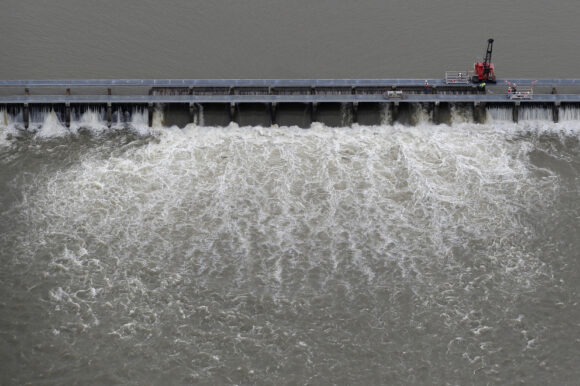The Bonnet Carré Spillway diverts Mississippi River flood flows away from New Orleans into Lake Pontchartrain, which connects to the Mississippi Channel and eventually the Gulf of Mexico.
The spillway has been opened only 15 times since construction was completed in 1931, but six of those openings occurred in the past 10 years. The flood gate had to be opened four times from 2019 to 2020, and for the first time was opened twice in a single year.
Communities in Southern Mississippi say the overflows wipe out oyster beds and suppress tourism — both vital elements of the local economy.
Two counties, several municipalities and business groups filed a lawsuit to force the US Army Corps of Engineers to reevaluate operation of the flood-control system. Their hopes were dashed when the 5th Circuit Court of Appeals affirmed a decision granting summary judgment in favor of the Corps in a published decision released Friday.
The appellate panel said that a narrow waiver of sovereign immunity contained in the Administrative Procedures Act for “major federal projects” does not apply to a flood-control system that has been operational for 90 years.
The plaintiffs argued that the National Environmental Protection Act required the Corps to complete a supplemental Environmental Impact Statement because more frequent flooding had changed the operation of the spillway.
“Continued implementation of a preexisting policy (even under shifting conditions) and adoption or consideration of a new policy are birds of a different feather,” the panel said. “Only the latter form of agency action requires supplementation of an existing EIS—ruling otherwise would create a freestanding obligation to supplement that would subject certain agencies to a never-ending game of environmental Whac-A-Mole.”
Harrison and Hancock counties, the city of Biloxi and groups representing hotel owners and commercial fishermen filed a lawsuit in 2019, after the Corps opened the Bonnet Carré twice in the same year and let the water continue flowing for 123 days. A Corps employee testified that before then, the spillway had been opened for a total of 333 days in its entire existence.
The plaintiffs said the diversion brought water polluted with nitrates and phosphorus into Mississippi waters, decimating oyster beds and bringing toxic algae blooms that forced public health officials to close area beaches. Commercial fishers lost their livelihoods and tourists abandoned family vacations, the complaint says.
The plaintiffs argued that the Corps was required to undergo a supplemental EIS to reevaluate operation of the spillway to take into account conditions that were not forseen when the spillway was authorized by Congress in 1928.
“If decimated oyster beds, closed beaches and toxic algae blooms on a regional scale do not warrant some thought on the part of the Corps to alternative strategies, it is hard to imagine what would,” the plaintiffs said.
The federal government cannot be sued, however, unless Congress had passed a statute providing a specific waiver. The Mississippi communities said the Administrative Procedures Act contains just such a waiver for matters that involve decisionmaking for “major federal projects.”
A US District Judge for the Southern District of Mississippi granted summary judgment in favor of the Corps, ruling that nothing in National Environmental Protection Act requires an agency to complete a supplemental environmental impact report for a project that has been operating continuously for decades.
The 5th Circuit panel agreed, saying in its opinion that “significant new circumstances alone do not necessarily obligate an agency to prepare a supplemental EIS, no matter how great their influence on the environmental concerns NEPA was enacted to address.”
“Because the Corps has no duty to prepare the supplemental EIS the plaintiffs seek, the plaintiffs have no APA claim for unlawful agency inaction, and the Corps is immune from their suit claiming otherwise,” the panel concluded.
Top photo: In this May 10, 2019 file photo, workers open bays of the Bonnet Carre Spillway, to divert rising water from the Mississippi River to Lake Pontchartrain, upriver from New Orleans, in Norco, La. The major flood control structure on the Mississippi River may have to soon be opened up to ease pressure on New Orleans levees, federal authorities said Tuesday, March 31, 2020. The river is expected to crest above 17 feet (5.2 meters) at a key New Orleans gauge as early as Friday, April 3, 2020, the U.S. Army Corps of Engineers said in a news release. That would likely lead to the opening of a structure that diverts water through the Bonnet Carré Spillway. (AP Photo/Gerald Herbert, File)
Was this article valuable?
Here are more articles you may enjoy.


 First Brands Judge Approves Examiner to Probe Fraud Allegations
First Brands Judge Approves Examiner to Probe Fraud Allegations  Musk’s xAI Faces California AG Probe Over Grok Sexual Images
Musk’s xAI Faces California AG Probe Over Grok Sexual Images  Palantir Poaching Suit Called ‘Scare’ Tactic by Ex-Employees
Palantir Poaching Suit Called ‘Scare’ Tactic by Ex-Employees  Allianz Built An AI Agent to Train Claims Professionals in Virtual Reality
Allianz Built An AI Agent to Train Claims Professionals in Virtual Reality 